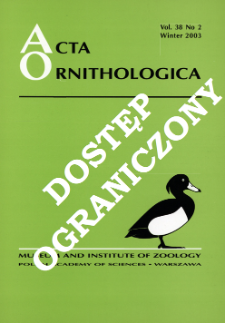
Object
Title: Feeding activity and seasonal changes in prey composition of urban peregrine falcons Falco peregrinus
Subtitle:
Acta Ornithologica, vol. 36, no. 2 ; Częstotliwość karmienia piskląt i sezonowe zmiany w składzie pokarmu miejskich sokołów wędrownych w Warszawie
Contributor:
Polska Akademia Nauk. Muzeum i Instytut Zoologii
Publisher:
Muzeum i Instytut Zoologii PAN
Place of publishing:
Description:
Bibliogr. p. 168-169 ; P. [165]-169 : ill. ; 27 cm ; Abstract in Polish. Taxa in Latin
Type of object:
Abstract:
Despite the increasing populations of Peregrine Falcons in European cities, detailed quantitative studies of their diet composition and feeding activity in urban environments are rare. The results from observations in Warsaw have added to the knowledge of the feeding ecology of urban raptors. In 2000 and 2001 the same pair of Peregrines bred successfully in nest boxes situated on two different buildings in the city centre, rearing three and four chicks in the respective years. During the breeding seasons from hatching to fledging, the nests were monitored with a video camera. Only diurnal observations were used in the detailed analysis of feeding activity - 428 h in 2000 (33 days) and 384 h (24 days) in 2001. Two peaks of parental activity were noted: in the morning and in the afternoon. Additional data collected in 2000 showed that the falcons also fed their young at night. In 1998-2001 486 prey remains were collected on the buildings occupied by the Peregrines. In Warsaw these falcons preyed most often on Feral Pigeons (32%), and also on various thrush species (23.5%), Skylarks (8%) and Corncrakes (5.6%). Seasonal variations in prey composition were identified. During the spring and autumn migrations, the proportion of pigeons in the falcons' diet was 10-19%, while in summer and winter it was over 40%. The trend was reversed with regard to migrant species, which were prevalent in the diet in spring and autumn, but less numerous in summer and winter.
Relation:
Volume:
Issue:
Start page:
End page:
Detailed Resource Type:
Format:
Resource Identifier:
Source:
MiIZ PAN, call no. P.257, Vol. 36, No 2 ; MiIZ PAN, call no. P.4568, Vol. 36, No 2 ; click here to follow the link
Language:
Rights:
Rights Reserved - Restricted Access
Terms of use:
Digitizing institution:
Museum and Institute of Zoology of the Polish Academy of Sciences
Original in:
Library of the Museum and Institute of Zoology of the Polish Academy of Sciences
Projects co-financed by:
Programme Innovative Economy, 2010-2014, Priority Axis 2. R&D infrastructure ; European Union. European Regional Development Fund
Access:
Object collections:
- Digital Repository of Scientific Institutes > Partners' collections > Museum and Institute of Zoology PAS > Scientific Journals
- Digital Repository of Scientific Institutes > Partners' collections > Museum and Institute of Zoology PAS > MIZ PAN Publications > Acta Ornithologica
- Digital Repository of Scientific Institutes > Literature > Journals/Articles
Last modified:
Oct 2, 2020
In our library since:
May 23, 2014
Number of object content downloads / hits:
74
All available object's versions:
https://rcin.org.pl/publication/61362
Show description in RDF format:
Show description in RDFa format:
Show description in OAI-PMH format:
| Edition name | Date |
|---|---|
| Feeding activity and seasonal changes in prey composition of urban peregrine falcons Falco peregrinus / Rejt, Łukasz | Oct 2, 2020 |
Objects Similar
Wiśniewski, Grzegorz Tułodziecki, Kazimierz Tomaszewski, Jacek
Sielicki, Czesław (1933–1996) Sielicki, Janusz
Wiśniewski, Grzegorz
Luniak, Maciej (1936– )
Mizera, Tadeusz (1954– ) Sielicki, Janusz
Galušin, Vladimir Mihajlovič

 INSTYTUT ARCHEOLOGII I ETNOLOGII POLSKIEJ AKADEMII NAUK
INSTYTUT ARCHEOLOGII I ETNOLOGII POLSKIEJ AKADEMII NAUK
 INSTYTUT BADAŃ LITERACKICH POLSKIEJ AKADEMII NAUK
INSTYTUT BADAŃ LITERACKICH POLSKIEJ AKADEMII NAUK
 INSTYTUT BADAWCZY LEŚNICTWA
INSTYTUT BADAWCZY LEŚNICTWA
 INSTYTUT BIOLOGII DOŚWIADCZALNEJ IM. MARCELEGO NENCKIEGO POLSKIEJ AKADEMII NAUK
INSTYTUT BIOLOGII DOŚWIADCZALNEJ IM. MARCELEGO NENCKIEGO POLSKIEJ AKADEMII NAUK
 INSTYTUT BIOLOGII SSAKÓW POLSKIEJ AKADEMII NAUK
INSTYTUT BIOLOGII SSAKÓW POLSKIEJ AKADEMII NAUK
 INSTYTUT CHEMII FIZYCZNEJ PAN
INSTYTUT CHEMII FIZYCZNEJ PAN
 INSTYTUT CHEMII ORGANICZNEJ PAN
INSTYTUT CHEMII ORGANICZNEJ PAN
 INSTYTUT FILOZOFII I SOCJOLOGII PAN
INSTYTUT FILOZOFII I SOCJOLOGII PAN
 INSTYTUT GEOGRAFII I PRZESTRZENNEGO ZAGOSPODAROWANIA PAN
INSTYTUT GEOGRAFII I PRZESTRZENNEGO ZAGOSPODAROWANIA PAN
 INSTYTUT HISTORII im. TADEUSZA MANTEUFFLA POLSKIEJ AKADEMII NAUK
INSTYTUT HISTORII im. TADEUSZA MANTEUFFLA POLSKIEJ AKADEMII NAUK
 INSTYTUT JĘZYKA POLSKIEGO POLSKIEJ AKADEMII NAUK
INSTYTUT JĘZYKA POLSKIEGO POLSKIEJ AKADEMII NAUK
 INSTYTUT MATEMATYCZNY PAN
INSTYTUT MATEMATYCZNY PAN
 INSTYTUT MEDYCYNY DOŚWIADCZALNEJ I KLINICZNEJ IM.MIROSŁAWA MOSSAKOWSKIEGO POLSKIEJ AKADEMII NAUK
INSTYTUT MEDYCYNY DOŚWIADCZALNEJ I KLINICZNEJ IM.MIROSŁAWA MOSSAKOWSKIEGO POLSKIEJ AKADEMII NAUK
 INSTYTUT PODSTAWOWYCH PROBLEMÓW TECHNIKI PAN
INSTYTUT PODSTAWOWYCH PROBLEMÓW TECHNIKI PAN
 INSTYTUT SLAWISTYKI PAN
INSTYTUT SLAWISTYKI PAN
 SIEĆ BADAWCZA ŁUKASIEWICZ - INSTYTUT TECHNOLOGII MATERIAŁÓW ELEKTRONICZNYCH
SIEĆ BADAWCZA ŁUKASIEWICZ - INSTYTUT TECHNOLOGII MATERIAŁÓW ELEKTRONICZNYCH
 MUZEUM I INSTYTUT ZOOLOGII POLSKIEJ AKADEMII NAUK
MUZEUM I INSTYTUT ZOOLOGII POLSKIEJ AKADEMII NAUK
 INSTYTUT BADAŃ SYSTEMOWYCH PAN
INSTYTUT BADAŃ SYSTEMOWYCH PAN
 INSTYTUT BOTANIKI IM. WŁADYSŁAWA SZAFERA POLSKIEJ AKADEMII NAUK
INSTYTUT BOTANIKI IM. WŁADYSŁAWA SZAFERA POLSKIEJ AKADEMII NAUK


































